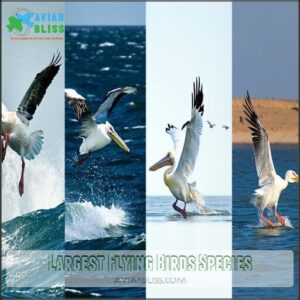This site is supported by our readers. We may earn a commission, at no cost to you, if you purchase through links.

The Andean condor takes the crown for weight, tipping scales at up to 33 pounds while soaring effortlessly over the Andes. Then there’s the great bustard, dubbed the “flying tank”, weighing up to 40 pounds but still managing liftoff.
Birds like the snowy albatross and Dalmatian pelican bring their own supersized stats too. These airborne giants remind us that nature doesn’t skimp on awe.
Curious about their survival stories? Stay tuned!
Table Of Contents
Key Takeaways
- You’ll find the wandering albatross has the largest wingspan, stretching over 12 feet, making it unbeatable for long glides across oceans.
- The Andean condor holds the title for the heaviest high-flying bird, weighing up to 33 pounds and soaring over the Andes.
- The great bustard is the heaviest overall flying bird, with males reaching up to 40 pounds, albeit with limited flight ability.
- Dalmatian pelicans and snowy albatrosses stand out for their vast wingspans and efficient soaring, but both face conservation threats requiring habitat protection.
Largest Flying Birds Overview
You’ll be amazed at how nature designs its high-fliers, combining massive size with the ability to soar.
Nature’s high-fliers blend immense size with effortless soaring, showcasing breathtaking adaptations that defy gravity and rule the skies.
From record-breaking wingspans to impressive weights, the largest flying birds showcase extraordinary adaptations that make them rulers of the skies.
Wandering Albatross Characteristics
The Wandering Albatross is a true master of soaring flight, with the largest bird wingspan on Earth, reaching up to 12.1 feet.
It thrives in remote habitat regions like the Southern Ocean.
Here’s what sets it apart:
- Wings built for effortless gliding.
- Mating rituals lasting a lifetime.
- Diet analysis reveals fish, squid, and krill favorites.
- Lifespan extremes—up to 50 years!
Snowy Albatross Wingspan
The Snowy Albatross stands tall among the largest flying birds with a staggering wingspan size reaching up to 3.7 meters.
Its dynamic soaring lets it glide vast foraging ranges across the ocean.
Plumage variation adds charm, showcasing black-tinged wings and a striking white body.
Found near remote breeding islands, their conservation threats make protecting this majestic albatross size critical for future generations, which is a matter of conservation.
Southern Royal Albatross Size
The Southern Royal Albatross, or Diomedea epomophora, is a majestic marvel among the largest flying birds.
Its wingspan size reaches up to 3.5 meters (11.5 feet), showcasing impressive wingspan variation.
One key factor is their impressive adaptation to environment.
Here’s what affects its size:
- Sexual Dimorphism – Males are larger.
- Juvenile Size – Growth spurt dependent.
- Diet Influence – Nutrient-rich food is pivotal.
- Measurement Accuracy – Essential for scientific records.
Largest Flying Birds Species
In terms of the largest flying birds, their size is downright awe-inspiring.
Each species has unique traits that make them giants of the skies. The Wandering Albatross, with its fascinating 60-year Albatross Lifespan, gracefully glides across oceans, barely needing to flap its wings.
On the other hand, Pelican Behavior is all about teamwork—Dalmatian Pelicans often fish in groups, creating a spectacle of synchronized effort. The Kori Bustard, known for its stunning Bustard Mating displays, is the heaviest flying bird, with some males puffing up their throats dramatically to attract mates.
Andean Condors, masters of efficiency, rely on a scavenger Condor Diet, soaring high while barely expending energy. These birds are a true bird size comparison marvel.
| Bird | Wingspan (ft) | Weight (lbs) |
|---|---|---|
| Wandering Albatross | 12.1 | 26 |
| Dalmatian Pelican | 11.5 | 33 |
| Kori Bustard | 9 | 44 |
| Andean Condor | 10.1 | 33 |
Birds by Wingspan Measurement
When you measure wingspans, you’ll find the Wanderings Albatross sets an impressive record at over 12 feet, while pelicans and other albatross species aren’t far behind.
These colossal wings help them soar across oceans and continents with remarkable efficiency, proving that size truly matters in the skies.
Dalmatian Pelican Wingspan
The Dalmatian Pelican boasts an impressive wingspan of up to 11.5 feet, putting it among the largest flying birds.
This pelican’s immense size enhances its flight efficiency, allowing graceful glides over southeastern Europe and Asia.
Wingspan variation highlights the species’ adaptability, while accurate measurement reveals its ecological role.
Conservation challenges persist as habitat impact threatens these awe-inspiring birds. These birds’ survival is threatened by entanglement in fishing gear.
Great White Pelican Size
The Great White Pelican is a stunning reminder of nature’s artistry.
With a wingspan reaching 3.6 meters, this bird’s size guarantees its place among the largest flying birds.
Its habitat influences its plumage variation, subtly reflecting local conditions.
Here are its standout traits:
- Wingspan: Up to 3.6 meters.
- Weight: Around 15 pounds.
- Diet effects: Mainly fish.
- Conservation impact: Least Concern.
- Distinctive pelican size guarantees easy recognition, making it a notable example of nature’s artistry.
Amsterdam Albatross Wingspan
The Amsterdam Albatross, one of the largest flying birds, boasts a wingspan of up to 11.2 feet.
Native to remote breeding grounds, these albatrosses showcase striking plumage details and use impressive foraging ranges over open oceans.
Classified as Endangered, their survival faces conservation threats, highlighting the importance of protecting these rare Diomedea amsterdamensis giants from further decline.
Kori Bustard Weight
The Amsterdam Albatross inspires awe, but let’s not overlook the Kori Bustard, the heaviest flying bird.
Males weigh up to 44 pounds, making flight a challenge.
Here’s why their weight matters:
- Bustard Diet: High-calorie meals power these stocky birds.
- Mating Rituals: Males inflate their esophagus impressively.
- Flight Mechanics: Wings are broad to sustain liftoff.
Amazing, right?
Heaviest Flying Birds Identified
You might be surprised to learn that some of the world’s largest flying birds carry impressive weight without sacrificing flight.
From the towering Sarus Crane to the hefty Great Bustard, these giants prove that gravity can be negotiated with the right adaptations.
Andean Condor Weight
The Andean Condor, among the largest flying birds, showcases impressive weight variations.
Males range between 25-33 pounds, while females weigh 18-24 pounds.
Weight fluctuates based on diet impacts, such as large meals limiting flight.
Curious how size compares?
The table provides a clear comparison of the weights between male and female Andean Condors, highlighting their average weight and maximum weight.
Trumpeter Swan Size
The Trumpeter Swan, one of the largest flying birds, impresses with its swan size and graceful presence.
- Swan Weight: Reaches up to 33 pounds.
- Wingspan Variation: Extends over 10 feet.
- Plumage Development: White feathers mature after two years.
- Habitat Influence: Found in North America’s wetlands.
It’s easy to appreciate their elegance and strength in flight!
Great Bustard Weight
Unlike the Trumpeter Swan, the Great Bustard holds its ground as one of the largest flying birds.
Its weight, reaching up to 40 pounds, reflects its specialized diet and impressive bustard size.
Male bustards showcase striking sexual dimorphism, being much larger than females.
This heft can limit flight capabilities but highlights fascinating Bustard Weight Factors with unique conservation implications tied to its habitat and diet.
Sarus Crane Height
Standing up to 5.9 feet tall, the Sarus crane holds the title for tallest flying bird.
Its long legs and elegant neck make its height remarkable.
Found in wetlands across Asia and Australia, this species showcases impressive Crane Height Variation depending on gender and habitat.
Ostriches are taller than the Sarus crane.
When bird comparisons arise, the Sarus crane’s towering size highlights its position among the largest flying birds.
Rare Large Flying Birds Conservation
You’ve probably heard of majestic birds like the wandering albatross or the Andean condor, but did you know many of these giants are struggling to survive.
Conservation programs are racing against time to protect these rare fliers, balancing their ecological importance with growing environmental threats, which is a critical aspect of saving these species, and conservation efforts are essential to their survival.
Wandering Albatross Status
The Wandering Albatross, famous for its record-breaking wingspan of 12.1 feet, faces serious population threats.
The Wandering Albatross glides effortlessly on 12.1-foot wings, a majestic symbol of soaring freedom facing conservation challenges.
Habitat loss, climate impact, and fishing lines reduce breeding success. Listed as vulnerable on the IUCN Red List, conservation plans aim to protect this majestic bird.
Using responsible gear options can greatly reduce harm to albatrosses.
Here’s how you can support albatross conservation:
- Support sustainable fishing.
- Reduce ocean plastics.
- Back habitat protection efforts.
- Raise awareness.
Eurasian Black Vulture Population
The Eurasian Black Vulture faces challenges like habitat loss and poisoning threats, yet conservation strategies show promise.
With 2,739-2,749 breeding pairs in Europe and Spain leading in breeding success, these vultures play a key role in bird conservation.
Efforts focus on range expansion, ensuring this majestic Cinereous Vulture helps counter population decline while soaring over its shrinking wilderness.
You can even find Eurasian Black Vulture products online.
Andean Condor Conservation Efforts
Andean Condors, some of the largest flying birds, have made a comeback through focused conservation efforts.
Captive breeding programs, habitat preservation initiatives, and community involvement have been key.
Poisoning threats from carcasses remain a challenge, but monitoring programs help protect these majestic vultures.
You can find condor conservation gear that supports these efforts.
It’s inspiring to see how bird conservation continues to give these high-soaring giants a second chance.
Dalmatian Pelican Reintroduction Programs
Building on the Andean Condor’s recovery, Dalmatian Pelican reintroduction efforts exemplify conservation programs’ impact.
Protecting these vulnerable species means blending science and community involvement.
Consider this:
- Secure nesting platforms boost numbers.
- Habitat restoration revitalizes wetlands for pelicans and fish.
- Long-term monitoring guarantees genetic diversity.
- Collaboration connects regions.
- Program effectiveness hinges on repairing nature’s balance.
These initiatives align with bird conservation efforts to protect vulnerable species.
Saving pelicans heals ecosystems and is a key part of conservation programs that focus on vulnerable species, which is crucial for maintaining genetic diversity.
Frequently Asked Questions (FAQs)
What is the biggest high flying bird?
The Andean condor, soaring over the Andes, takes the crown for high-altitude flight.
With wings spanning up to 1 feet and special hemoglobin, it thrives where oxygen thins—nature’s ultimate glider at breathtaking heights.
How do large birds adapt for survival?
Big birds survive by mastering flight efficiency, using large wings for soaring with minimal energy.
Their size deters predators, while adaptations like sharp beaks, keen vision, and unique diets guarantee they thrive in tough environments.
What limits the size of flying birds?
Imagine wings so large they blot out the sun—sounds cool, right?
But it’s physics that reigns.
A bird’s size is limited by weight, wing strength, and energy demands needed to beat gravity’s relentless pull.
How do wingspans affect bird flight patterns?
Wingspans play a huge role in how birds fly.
Longer wings help glide effortlessly over long distances, while shorter, broader wings boost maneuverability and quick takeoffs.
It’s like choosing between a sports car and a cruise ship!
What do large birds eat in the wild?
Large birds eat a variety of foods depending on their habitat—fish, small mammals, carrion, or even insects.
You’ll find scavengers like condors dining on carcasses, while pelicans scoop up fish with their big, comical bills, and these birds can be considered carrion eaters in certain contexts.
Are all large birds migratory species?
Not all large birds migrate.
Some, like albatrosses, travel vast distances over oceans, while others, like bustards, stay local.
Migration often depends on food availability, climate, and breeding habits—not just size alone.
Conclusion
Exploring the largest flying birds is like opening nature’s treasure chest.
From the wandering albatross with its surfboard-like wingspan to the great bustard, a true “flying tank,” these birds remind us of evolution’s incredible creativity.
You’ll find that each species dominates in wingspan, weight, or height, showcasing unique adaptations for survival.
Whether it’s the Andean condor’s effortless gliding or the Dalmatian pelican’s elegant flight, the largest flying birds truly redefine what’s possible in the skies with their remarkable abilities, making them a testament to evolution’s incredible power.
- https://planetofbirds.com/largest-flying-birds-in-the-world/
- https://factanimal.com/animal-facts/largest-flying-birds-in-the-world/
- https://www.reddit.com/r/Ornithology/comments/1aq5yah/top_ten_largest_flying_birds_ever/
- https://animals.howstuffworks.com/birds/largest-flying-bird.htm
- https://abcbirds.org/blog/largest-birds-of-the-americas/














